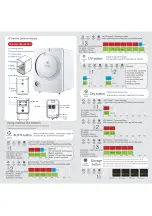iConnectivity
iConnectMIDI™ Owner’s Manual
Revision 0.5
Page 22
Owner’s Manual
iOS Connectivity
iPad™, iPod touch®, and iPhone®
iConnectMIDI interfaces to iOS devices through a wired high-speed USB connection. The cable
for the connection between iConnectMIDI and iOS is included and contains a mini-USB
connector (which plugs into one of the mini-USB receptacles on iConnectMIDI) on one end and
a 30-pin connector (which plugs into the iOS device) on the other.
The 30-pin connector locks to prevent accidental detachment of the cable from the iOS device.
When disconnecting the cable from your iOS device, ensure that the side buttons on the
connector casing are first depressed before trying to pull the connector out of its receptacle.
When connecting the cable to the iOS device, push the connector into its receptacle until it
clicks into place.
Power Considerations
iOS devices
iConnectMIDI will not power a connected iOS device from either of its two mini-USB
connectors. The iOS device will draw on its own battery power; depending on its usage and the
number of applications running, the iOS device will eventually need to be recharged.
USB devices
iConnectMIDI will power one USB device from its USB-A connector. To use more than one
USB device, a powered USB hub is required for all USB devices to be connected to. Connect
the USB hub to iConnectMIDI with a USB cable.
Software
What can I do with all of this?
The iOS platform requires applications to be CoreMIDI compatible to work with iConnectMIDI.
The CoreMIDI framework is Apple’s way of letting programmers get MIDI functionality to the
applications more easily. For you, the MIDI user, this means that more music-related
applications are available to you and with greater functionality, allowing you to find the right
applications for your specific needs (and usually at very little cost). Because of the inherent
simplicity of most applications (due to the limited screen real estate of iPhone and iPod touch
devices), many applications are developed for specific tasks in mind, thus simplifying their
interfaces. Applications for the iPad, with its larger touch screen, are capable of more user-
interaction with the user and, as a result, have a larger feature set with greater complexity,
approaching that of the computer platforms.
On the Mac and PC computer platforms, MIDI functionality is as it always has been, with each
operating system providing its own form of MIDI capabilities for programmers and users. All of
the MIDI ports on iConnectMIDI will appear as you would expect and are accessible using the
standard methods of selecting MIDI ports.

















